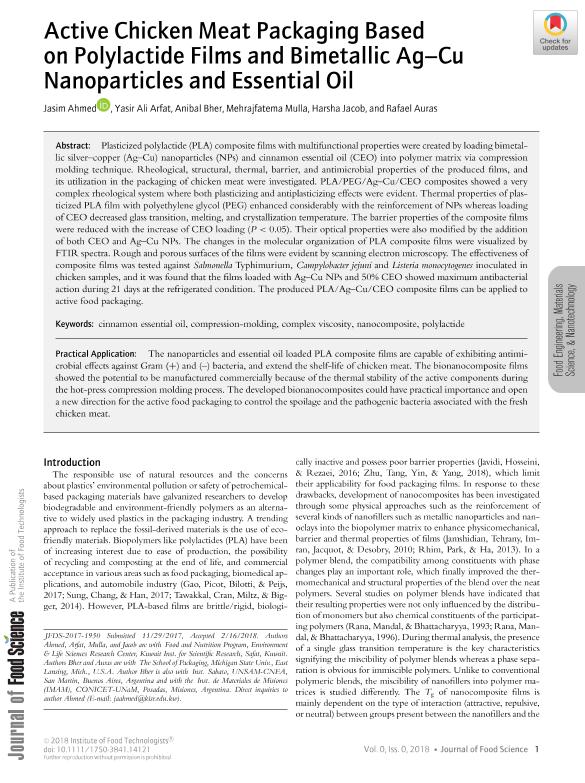Mostrar el registro sencillo del ítem
dc.contributor.author
Ahmed, Jasim
dc.contributor.author
Arfat, Yasir Ali
dc.contributor.author
Bher, Anibal Ricardo

dc.contributor.author
Mulla, Mehrajfatema
dc.contributor.author
Jacob, Harsha
dc.contributor.author
Auras, Rafael

dc.date.available
2019-10-25T17:53:00Z
dc.date.issued
2018-05
dc.identifier.citation
Ahmed, Jasim; Arfat, Yasir Ali; Bher, Anibal Ricardo; Mulla, Mehrajfatema; Jacob, Harsha; et al.; Active Chicken Meat Packaging Based on Polylactide Films and Bimetallic Ag–Cu Nanoparticles and Essential Oil; Wiley Blackwell Publishing, Inc; Journal of Food Science; 83; 5; 5-2018; 1299-1310
dc.identifier.issn
0022-1147
dc.identifier.uri
http://hdl.handle.net/11336/87300
dc.description.abstract
Plasticized polylactide (PLA) composite films with multifunctional properties were created by loading bimetallic silver–copper (Ag–Cu) nanoparticles (NPs) and cinnamon essential oil (CEO) into polymer matrix via compression molding technique. Rheological, structural, thermal, barrier, and antimicrobial properties of the produced films, and its utilization in the packaging of chicken meat were investigated. PLA/PEG/Ag–Cu/CEO composites showed a very complex rheological system where both plasticizing and antiplasticizing effects were evident. Thermal properties of plasticized PLA film with polyethylene glycol (PEG) enhanced considerably with the reinforcement of NPs whereas loading of CEO decreased glass transition, melting, and crystallization temperature. The barrier properties of the composite films were reduced with the increase of CEO loading (P < 0.05). Their optical properties were also modified by the addition of both CEO and Ag–Cu NPs. The changes in the molecular organization of PLA composite films were visualized by FTIR spectra. Rough and porous surfaces of the films were evident by scanning electron microscopy. The effectiveness of composite films was tested against Salmonella Typhimurium, Campylobacter jejuni and Listeria monocytogenes inoculated in chicken samples, and it was found that the films loaded with Ag–Cu NPs and 50% CEO showed maximum antibacterial action during 21 days at the refrigerated condition. The produced PLA/Ag–Cu/CEO composite films can be applied to active food packaging. Practical Application: The nanoparticles and essential oil loaded PLA composite films are capable of exhibiting antimicrobial effects against Gram (+) and (–) bacteria, and extend the shelf-life of chicken meat. The bionanocomposite films showed the potential to be manufactured commercially because of the thermal stability of the active components during the hot-press compression molding process. The developed bionanocomposites could have practical importance and open a new direction for the active food packaging to control the spoilage and the pathogenic bacteria associated with the fresh chicken meat.
dc.format
application/pdf
dc.language.iso
eng
dc.publisher
Wiley Blackwell Publishing, Inc

dc.rights
info:eu-repo/semantics/openAccess
dc.rights.uri
https://creativecommons.org/licenses/by-nc-nd/2.5/ar/
dc.subject
CINNAMON ESSENTIAL OIL
dc.subject
COMPLEX VISCOSITY
dc.subject
COMPRESSION-MOLDING
dc.subject
NANOCOMPOSITE
dc.subject
POLYLACTIDE
dc.subject.classification
Ingeniería de los Materiales

dc.subject.classification
Ingeniería de los Materiales

dc.subject.classification
INGENIERÍAS Y TECNOLOGÍAS

dc.title
Active Chicken Meat Packaging Based on Polylactide Films and Bimetallic Ag–Cu Nanoparticles and Essential Oil
dc.type
info:eu-repo/semantics/article
dc.type
info:ar-repo/semantics/artículo
dc.type
info:eu-repo/semantics/publishedVersion
dc.date.updated
2019-10-17T14:54:08Z
dc.journal.volume
83
dc.journal.number
5
dc.journal.pagination
1299-1310
dc.journal.pais
Reino Unido

dc.journal.ciudad
Londres
dc.description.fil
Fil: Ahmed, Jasim. Kuwait Institute for Scientific Research; Kuwait
dc.description.fil
Fil: Arfat, Yasir Ali. Kuwait Institute for Scientific Research; Kuwait
dc.description.fil
Fil: Bher, Anibal Ricardo. Universidad Nacional de San Martín; Argentina. Michigan State University; Estados Unidos. Consejo Nacional de Investigaciones Científicas y Técnicas. Centro Científico Tecnológico Conicet - Nordeste. Instituto de Materiales de Misiones. Universidad Nacional de Misiones. Facultad de Ciencias Exactas Químicas y Naturales. Instituto de Materiales de Misiones; Argentina
dc.description.fil
Fil: Mulla, Mehrajfatema. Kuwait Institute for Scientific Research; Kuwait
dc.description.fil
Fil: Jacob, Harsha. Kuwait Institute for Scientific Research; Kuwait
dc.description.fil
Fil: Auras, Rafael. Michigan State University; Estados Unidos
dc.journal.title
Journal of Food Science

dc.relation.alternativeid
info:eu-repo/semantics/altIdentifier/doi/http://dx.doi.org/10.1111/1750-3841.14121
dc.relation.alternativeid
info:eu-repo/semantics/altIdentifier/url/https://onlinelibrary.wiley.com/doi/abs/10.1111/1750-3841.14121
Archivos asociados
